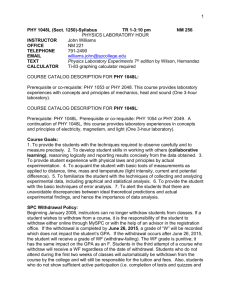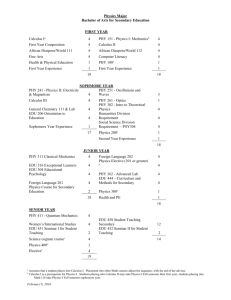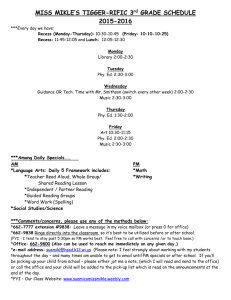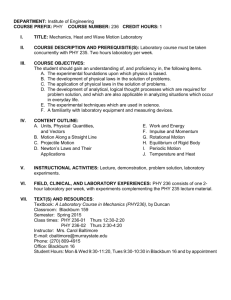Power Point
advertisement
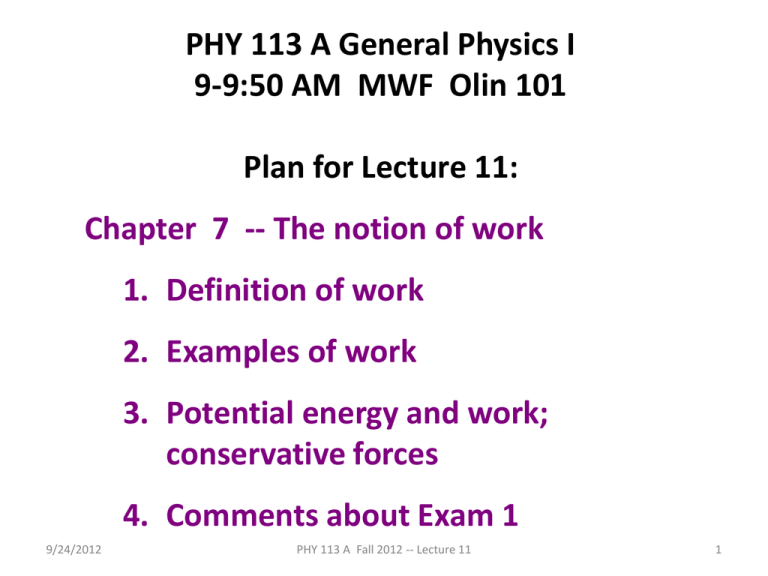
PHY 113 A General Physics I 9-9:50 AM MWF Olin 101 Plan for Lecture 11: Chapter 7 -- The notion of work 1. Definition of work 2. Examples of work 3. Potential energy and work; conservative forces 4. Comments about Exam 1 9/24/2012 PHY 113 A Fall 2012 -- Lecture 11 1 9/24/2012 PHY 113 A Fall 2012 -- Lecture 11 2 Comments about Exam 1 Scores 70 ≤ G ≤ 100 Please keep working hard, even if your score is 90 ≤ G ≤ 100 Please make an appointment to see me if your score is 70 ≤ G ≤ 90 Solutions will be posted on the web on the course website (you will have to login with your WFU login and password) 9/24/2012 PHY 113 A Fall 2012 -- Lecture 11 3 Energy work, kinetic energy Force effects acceleration rf Wi f F dr A related quantity is Work ri F dr ri 9/24/2012 rj PHY 113 A Fall 2012 -- Lecture 11 4 Definition of vector “dot” product q A B AB cos q Note that if q 90 , then A B 0 o 9/24/2012 PHY 113 A Fall 2012 -- Lecture 11 5 Definition of vector “dot” product q A B AB cos q Example : A 5, B 15, q 120 o A B (5)(15) cos120 37.5 (scalar) o 9/24/2012 PHY 113 A Fall 2012 -- Lecture 11 6 Definition of vector “dot” product -- continued q Suppose A Ax ˆi Ay ˆj and B Bx ˆi B y ˆj A B Ax Bx Ay B y Note that the result of a vector dot product is a scalar. Example : A 2ˆi 4ˆj and B 1ˆi 3ˆj A B 2 1 4 3 10 9/24/2012 PHY 113 A Fall 2012 -- Lecture 11 7 F Definition of work: dr rf ri rj Wi f F dr ri Units of work : Work Newtons meters Joules 1 J 0.239 cal 9/24/2012 PHY 113 A Fall 2012 -- Lecture 11 8 Units of work: work = force · displacement = (N · m) = (joule) •Only the component of force in the direction of the displacement contributes to work. •Work is a scalar quantity. •If the force is not constant, the integral form must be used. •Work can be defined for a specific force or for a combination of forces rf W1 F1 dr ri 9/24/2012 rf W2 F2 dr rf W1 2 (F1 F2 ) dr W1 W2 ri PHY 113 A Fall 2012 -- Lecture 11 ri 9 iclicker question: A ball with a weight of 5 N follows the trajectory shown. What is the work done by gravity from the initial ri to final displacement rf? 2.5m rf ri 1m 1m (A) 0 J 9/24/2012 10 m (B) 7.5 J (C) 12.5 J (D) 50 J PHY 113 A Fall 2012 -- Lecture 11 10 Gravity does negative work: Gravity does positive work: ri rf r 0 r 0 mg mg ri W=mg(rfri)<0 9/24/2012 rf W=mg(rfri)>0 PHY 113 A Fall 2012 -- Lecture 11 11 rf Wi f F dr Work done by a variable force: ri In this case : rf xf ri xi Wi f F dr Fx dx 9/24/2012 PHY 113 A Fall 2012 -- Lecture 11 12 Example: rf xf ri xi Wi f F dr Fx dx (5 N )(4m) 12 5 N 2m 25 J 9/24/2012 PHY 113 A Fall 2012 -- Lecture 11 13 Example – spring force: 9/24/2012 Fx = - kx PHY 113 A Fall 2012 -- Lecture 11 14 F Positive work x Negative work 9/24/2012 PHY 113 A Fall 2012 -- Lecture 11 15 Detail: rf xf Wi f F dr Fx dx ri 9/24/2012 xi xf kx dx xi PHY 113 A Fall 2012 -- Lecture 11 1 2 kx 2 xf xi 12 k x 2f xi2 16 More examples: Suppose a rope lifts a weight of 1000N by 0.5m at a constant upward velocity of 4.9m/s. How much work is done by the rope? (A) 500 J (B) 750 J (C) 4900 J (D) None of these Suppose a rope lifts a weight of 1000N by 0.5m at a constant upward acceleration of 4.9m/s2. How much work is done by the rope? (A) 500 J (B) 750 J 9/24/2012 (C) 4900 J (D) None of these PHY 113 A Fall 2012 -- Lecture 11 17 iclicker exercise: Why should we define work? A. Because professor like to torture students. B. Because it is always good to do work C. Because it will help us understand motion. D. Because it will help us solve the energy crisis. Next time we will discuss the Work-Kinetic energy theorem. 9/24/2012 PHY 113 A Fall 2012 -- Lecture 11 18 n q FP fk mg xi xf Assume FP sinq <<mg Work of gravity? Work of FP? Work of fk? 9/24/2012 0 FP cos q (xf-xi) mkn (xf-xi)=mk(mg- FP sin q (xf-xi) PHY 113 A Fall 2012 -- Lecture 11 19 A man must lift a refrigerator of weight mg to a height h to get it to the truck. For which method does the man do more work: A. Vertically lifting the refrigerator at constant speed to height h? B. Moving the refrigerator up the ramp of length L at constant speed with h=L sin q. 9/24/2012 PHY 113 A Fall 2012 -- Lecture 11 20 iclicker exercise: Which of the following statements about friction forces are true. A. Friction forces always do positive work. B. Friction forces always do negative work. C. Friction forces can do either positive or negative work. 9/24/2012 PHY 113 A Fall 2012 -- Lecture 11 21


